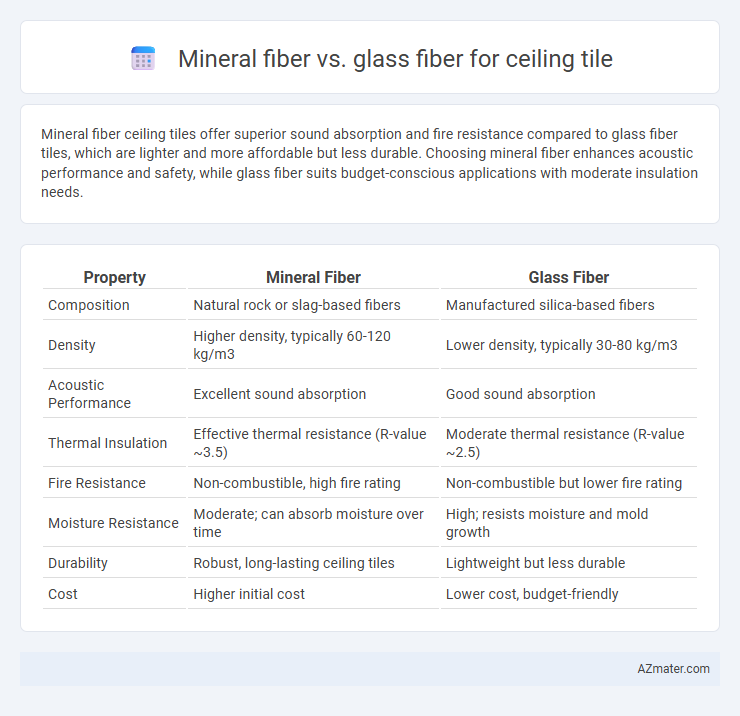Mineral fiber ceiling tiles offer superior sound absorption and fire resistance compared to glass fiber tiles, which are lighter and more affordable but less durable. Choosing mineral fiber enhances acoustic performance and safety, while glass fiber suits budget-conscious applications with moderate insulation needs.
Table of Comparison
| Property | Mineral Fiber | Glass Fiber |
|---|---|---|
| Composition | Natural rock or slag-based fibers | Manufactured silica-based fibers |
| Density | Higher density, typically 60-120 kg/m3 | Lower density, typically 30-80 kg/m3 |
| Acoustic Performance | Excellent sound absorption | Good sound absorption |
| Thermal Insulation | Effective thermal resistance (R-value ~3.5) | Moderate thermal resistance (R-value ~2.5) |
| Fire Resistance | Non-combustible, high fire rating | Non-combustible but lower fire rating |
| Moisture Resistance | Moderate; can absorb moisture over time | High; resists moisture and mold growth |
| Durability | Robust, long-lasting ceiling tiles | Lightweight but less durable |
| Cost | Higher initial cost | Lower cost, budget-friendly |
Introduction to Ceiling Tile Materials
Mineral fiber and glass fiber are two common materials used for ceiling tiles, each offering distinct acoustic and thermal properties. Mineral fiber tiles provide excellent sound absorption and fire resistance, making them ideal for commercial and institutional spaces. Glass fiber tiles are lightweight, moisture-resistant, and often preferred for environments requiring humidity control and enhanced durability.
What is Mineral Fiber?
Mineral fiber, commonly used in ceiling tiles, consists of a blend of natural and synthetic fibers derived from materials like basalt, slag, and other minerals, offering superior sound absorption and fire resistance. Unlike glass fiber, which is primarily made from fine strands of glass, mineral fiber tiles provide enhanced durability and moisture resistance, making them ideal for commercial and high-humidity environments. The unique composition of mineral fiber contributes to better acoustic performance and thermal insulation in ceiling systems.
What is Glass Fiber?
Glass fiber is a material made from thin strands of silica-based glass, known for its durability, lightweight nature, and excellent thermal and acoustic insulation properties, making it ideal for ceiling tiles. In comparison to mineral fiber, glass fiber offers superior resistance to moisture, mold, and fire, enhancing the longevity and safety of ceiling installations. Its non-porous surface also simplifies cleaning and maintenance, ensuring a cleaner indoor environment.
Key Differences: Mineral Fiber vs Glass Fiber
Mineral fiber ceiling tiles offer superior sound absorption and fire resistance compared to glass fiber tiles, making them ideal for acoustic and safety applications. Glass fiber tiles are lighter and more moisture-resistant, providing better durability in humid environments. Cost-wise, mineral fiber tiles tend to be more affordable but less flexible in design options than glass fiber alternatives.
Acoustic Performance Comparison
Mineral fiber ceiling tiles offer superior acoustic performance compared to glass fiber due to their higher density and sound absorption coefficients, typically ranging from 0.70 to 0.90 NRC (Noise Reduction Coefficient). Glass fiber tiles, while lightweight and resistant to moisture, generally have lower NRC values around 0.50 to 0.65, making them less effective in sound attenuation. Choosing mineral fiber tiles enhances noise control in commercial and office environments, promoting better speech intelligibility and overall acoustic comfort.
Fire Resistance Capabilities
Mineral fiber ceiling tiles exhibit superior fire resistance compared to glass fiber tiles due to their higher melting point and ability to withstand temperatures exceeding 1200degC without structural degradation. The inherent non-combustible nature of mineral fibers enhances fire safety by preventing flame spread and smoke production, making them ideal for fire-critical environments. Glass fiber tiles, while resistant to moderate heat, have lower thermal stability and can deform under intense fire conditions, reducing their effectiveness in fire containment.
Durability and Maintenance
Mineral fiber ceiling tiles offer superior durability due to their resistance to sagging, moisture, and sound absorption, making them ideal for long-term performance in humid environments. Glass fiber tiles are prone to more frequent maintenance challenges as they can deteriorate faster under moisture exposure and may require regular cleaning to prevent fiber degradation. Choosing mineral fiber over glass fiber ensures reduced maintenance costs and enhanced ceiling tile longevity in commercial and residential applications.
Environmental Impact and Sustainability
Mineral fiber ceiling tiles often incorporate recycled materials and offer better sound absorption, contributing to sustainable building practices by reducing waste and energy consumption. Glass fiber ceiling tiles, commonly made from recycled glass, provide superior durability and are also recyclable, minimizing landfill impact and supporting circular economy goals. Both materials have low VOC emissions, promoting indoor air quality and aligning with green building certification standards such as LEED.
Cost Analysis: Mineral Fiber vs Glass Fiber
Mineral fiber ceiling tiles generally offer a lower upfront cost compared to glass fiber tiles, making them a budget-friendly option for large-scale installations. Glass fiber tiles, while initially more expensive, provide enhanced durability and resistance to moisture, potentially reducing long-term maintenance and replacement expenses. An accurate cost analysis should consider both initial purchase prices and lifecycle costs, including installation, durability, and maintenance factors.
Choosing the Best Ceiling Tile Material
Mineral fiber ceiling tiles offer superior sound absorption and fire resistance compared to glass fiber, making them ideal for commercial and office environments requiring high acoustic performance and safety standards. Glass fiber tiles are lighter, less prone to sagging, and resist moisture better, suitable for areas with higher humidity or where lightweight materials are preferred. Selecting the best ceiling tile material depends on balancing acoustic needs, fire ratings, moisture resistance, and budget considerations.

Infographic: Mineral fiber vs Glass fiber for Ceiling tile
 azmater.com
azmater.com